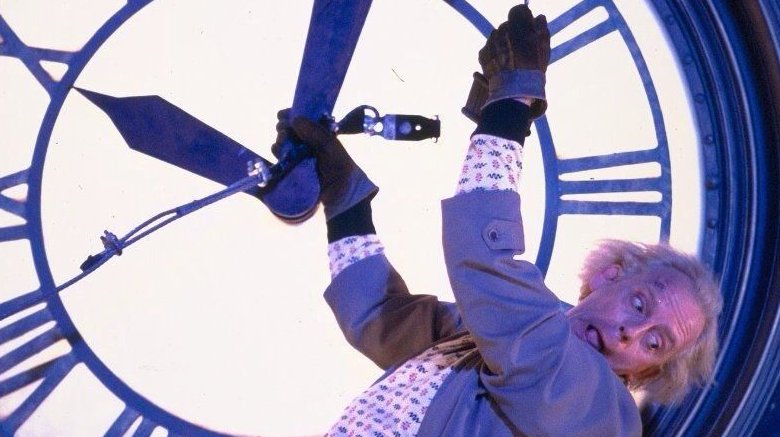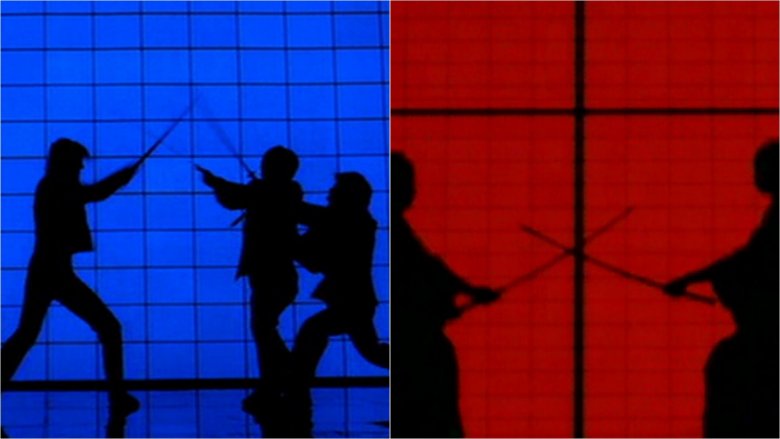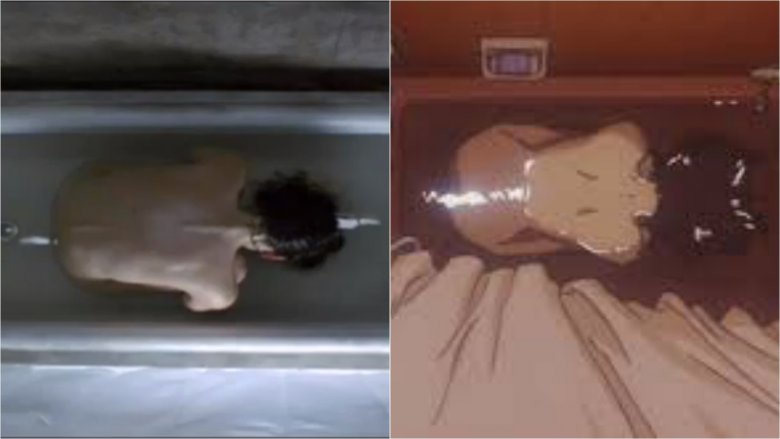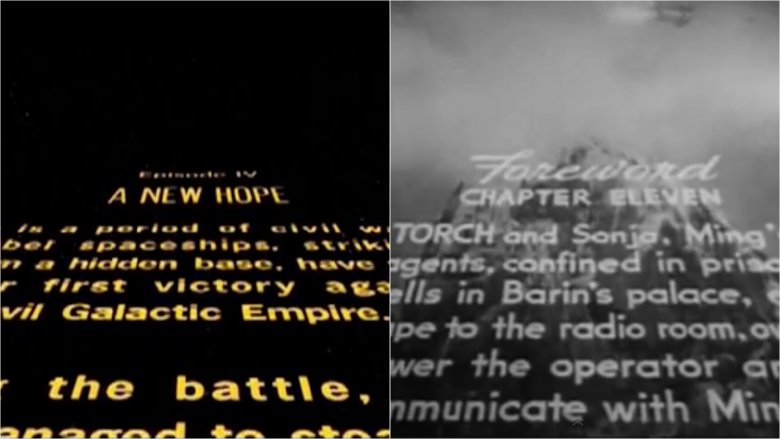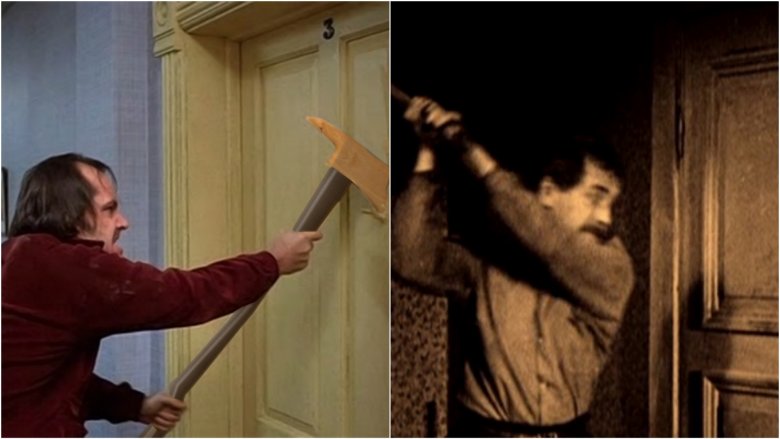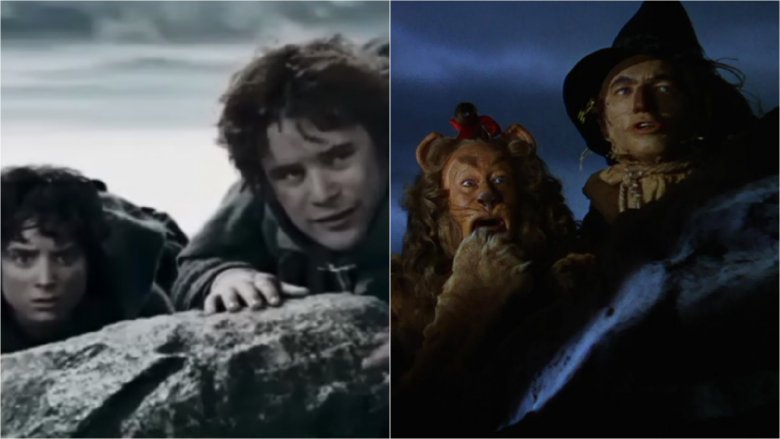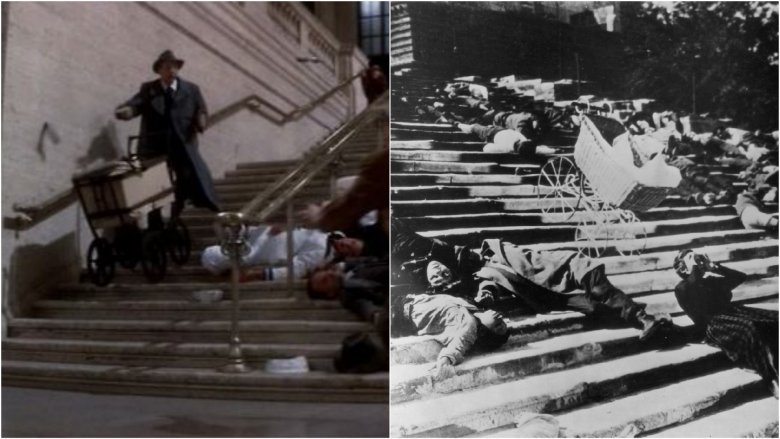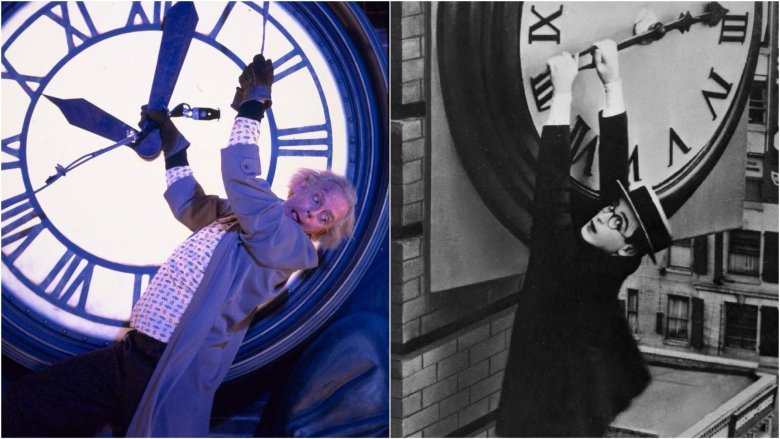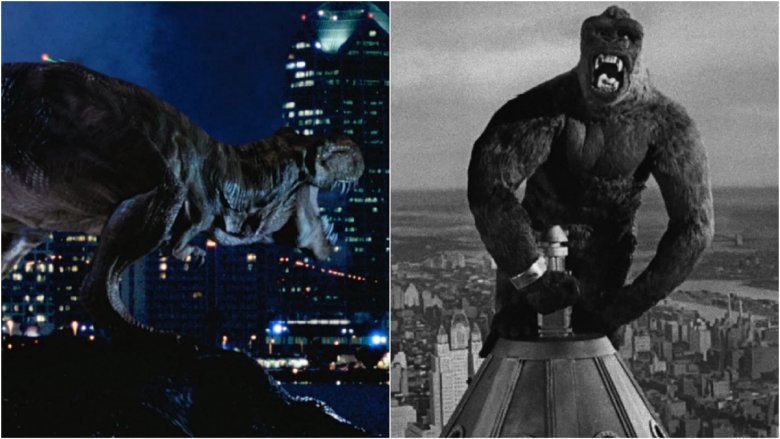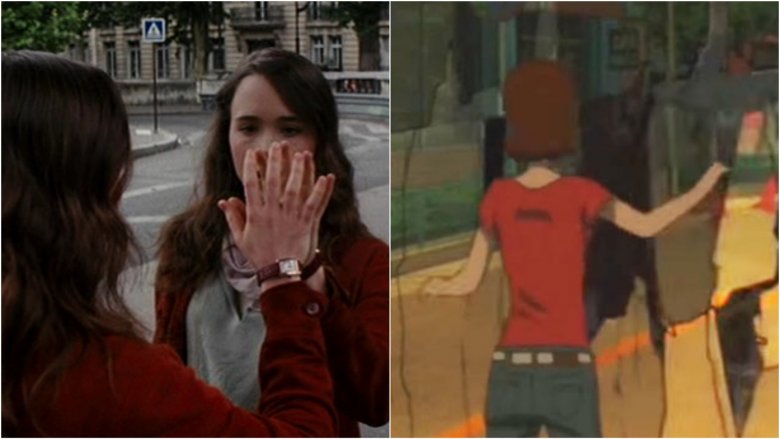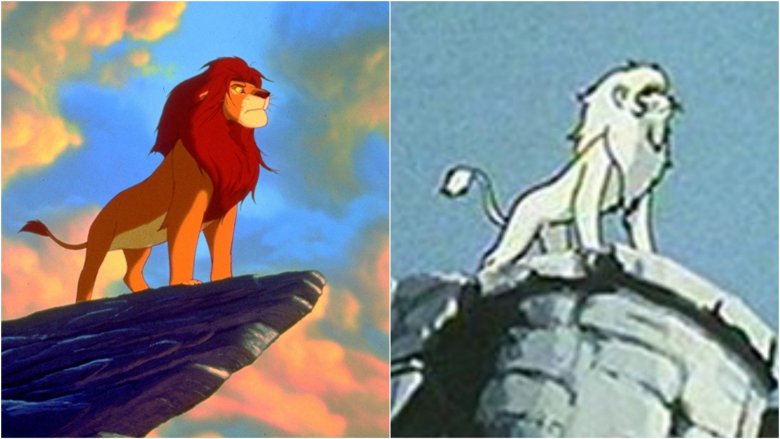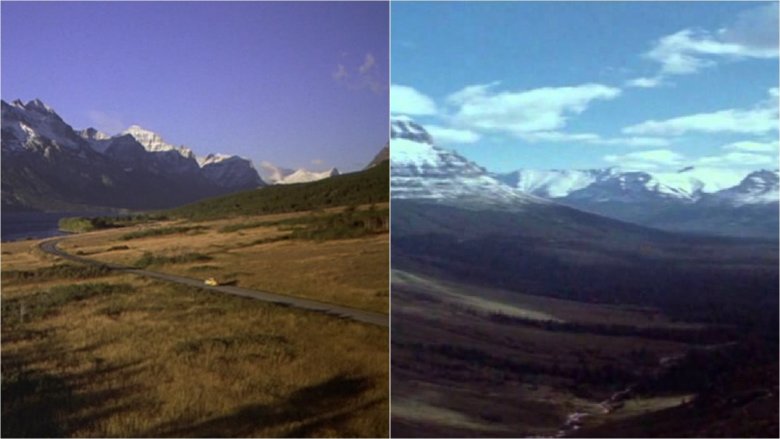Movie Scenes That Totally Ripped Off Other Films
With waves of sequels, remakes, reboots, and re-imaginings being touted by film studios all over Hollywood, it might be easier than ever to understand why people often say that there really aren't many new ideas in the movie business. But then, that's been true for decades now — in fact, as any hardcore film fan could tell you, the movie industry has a long-standing policy of looking the other way when filmmakers "pay homage" to scenes and setups from their favorite features.
By "paying homage," of course, we mean "totally ripping them off." If imitation truly is the highest form of flattery, then these pilfered movies should be blushing bright red — and the movies that ripped them off should probably be blushing for other reasons. While some of those ripoffs are obvious, others may require a little more digging. So without further adieu, here's a look back at some movie scenes that totally ripped off other films and took "homage" to a whole new level.
Silhouetted sword play - Kill Bill Vol. 1/Samurai Fiction
Quentin Tarantino has never been shy about using other movies as inspiration for his own work. In a 1994 interview, he infamously quipped, "I steal from every single movie ever made." He'd finish that thought by stating, "Great artists steal, they don't do homages."
If you haven't seen Tarantino's 2003 kung fu fantasia Kill Bill Vol. 1, you should know it's an epic genre mashup that refracts anime flicks, classic thrillers, and grindhouse greats through the prism of an epic martial arts film. Some might even say that Kill Bill Vol. 1 "homages" the hell out of several classics from each of those genres (i.e. Bruce Lee's kickass yellow jumpsuit from Game of Death), and Hiroyuki Nakano's 1998 samurai confection Samurai Fiction is most certainly amongst them.
It was the silhouetted opening titles to Nakano's samurai story that no doubt inspired one of Kill Bill Vol 1.'s most creative flourishes, the blue-lit backdrop that silhouettes the sword fight near the end of the Bride's bloody House of Blue Leaves showdown with The Crazy 88. Though Tarantino changes the color from Nakano's original red and manages to work the startling visuals into his narrative (brilliantly undercutting the bloodshed with a flawlessly executed moment of slapstick humor), the influence is simply impossible to ignore. Still, Kill Bill Vol. 1 arguably bests the Samurai Fiction moment that inspired it in terms of style, scale, and choreography.
Marion's underwater scream - Requiem For A Dream/Perfect Blue
Since making a name for himself with 1998's blisteringly visceral sci-fi drama Pi, Darren Aronofsky's work has been lauded for its creativity as much for its originality. Despite Aronofsky's eclectic catalogue and visionary reputation, he's been questioned on several occasions over the years about "borrowing" ideas from a legendary anime film, Satoshi Kon's pop-tinged shocker Perfect Blue.
Those questions appear to be quite valid. The film's plot is eerily similar to the troubled protagonist in Aronofsky's Black Swan, and both films find their protagonists crumbling under the pressures of their careers. As pressures mount in each film, the line between reality and fantasy blurs in increasingly unexpected ways. There's also the matter of the characters' names to consider (Mima in Perfect Blue and Nina in Black Swan).
As it happens, Black Swan isn't the only film in Aronofsky's catalogue that appears to have "borrowed" from Perfect Blue. In fact, there's a scene in Aronofsky's harrowing drug-addiction drama Requiem For A Dream that's essentially a straight ripoff. The scene in question finds Jennifer Connelly's unhinged Marion soaking in a bathtub. Aronofsky covers the moment with an overhead shot of Marion's back as she dunks her head underwater, then cuts to a closeup of the woman screaming into the water — a shot-for-shot copy of Mima's tub scene in Perfect Blue, even if it is equally effective.
Opening crawl - Star Wars/Flash Gordon
Sorry, Star Wars fans, but even George Lucas did some "borrowing" while building his galaxy far, far away. Over the years, Lucas has made no big secret of his love for the Saturday morning science fiction/adventure serials he devoured in his youth — or about how big an influence those serials played in crafting some of his most famous cinematic creations, Indiana Jones and the Star Wars universe in particular.
It should come as no surprise, then, that the live-action adaptation of Flash Gordon from the 1930s inspired Star Wars' opening crawl — you know, the one that gets us up to date with what's happening in the battle between The Galactic Empire and the Rebellion. Once again, this is a case of "inspired" translating to outright thievery, with Lucas even using said crawl to introduce each Star Wars film as a new episode. Still, while it might have been a ripoff, there's really no need to hate on Lucas for this. The influence was obvious to anyone from his generation when Star Wars came out, and all these years later, it's impossible to imagine the franchise without that opening crawl.
Jack axes the door - The Shining/The Phantom Carriage
Jack Nicholson taking an axe to a door while chasing Shelley Duvall through the Overlook Hotel in The Shining is one of horror cinema's most memorable moments. Full of mirth and menace and capped with one of the single all-time greatest line readings in a movie, it isn't just one of the most memorable moments in horror movie history, it's one of the most iconic in the history of cinema. It may come as a surprise, then, that director Stanley Kubrick totally ripped it off from another film.
Kubrick's inspiration was a silent Swedish release from 1921 called The Phantom Carriage. Based on a Swedish folk tale, it tells the story of a drunkard being confronted with his empty life by a supernatural being. As it happens, there's a point in the film when the drunkard ends up chasing his wife and son through their house. Mother and child escape to the bedroom, locking the door behind them, and — just as Jack does in The Shining — the man takes an axe to the door.
We don't get any of that good old Jack Nicholson "Here's Johnny!" lunacy (The Phantom Carriage is a silent film, after all), but the man more than shows his crazy before axing his way in, which leaves little question that the notoriously exacting Kubrick had this haunting moment in mind when he shot the one we know and love.
Discovering the gates of Mordor - Lord of the Rings: The Two Towers/The Wizard of Oz
Peter Jackson's Lord of the Rings trilogy has been lauded as one of the greatest fantasy film franchises in history. Of course, the franchise's noble legacy is inextricably tied to J.R.R. Tolkien's epically scaled, wildly original books that first saw Frodo and friends hit the road to Mordor.
As in Tolkien's books, one of the film trilogy's more memorable scenes comes in The Two Towers, and finds Sam, Frodo, and Gollum first laying eyes on the gargantuan gates to Sauron's nefarious realm. In that beautifully visualized shot, the weary travelers come to a rocky precipice, then nervously peer over the edge to find the ominous gate and heavily armed enemy soldiers marching along in formation.
While the moment undoubtedly hews close to the text in Tolkien's book, the scene in the film was just as certainly cribbed from another cinematic fantasy: 1939's The Wizard Oz. The Lion, the Tin Man, and the Scarecrow share a strikingly similar moment of discovery when they first come across the Wicked Witch's castle, which is presented in a shot that finds the heroes nervously peering over some rocks to see the gate. And wouldn't you know it, soldiers are marching by in formation. Hey, at least Jackson stole from a legend, right?
Stroller tumbling down the stairs - The Untouchables/Battleship Potemkin
Hollywood's penchant for stealing from themselves is well documented, but American studios have just as big of a rep for stealing from films produced in foreign markets. That includes ripping a scene off from one of the most influential films ever produced in Europe, Sergei Eisenstein's groundbreaking 1925 drama Battleship Potemkin.
Eisenstein's trailblazing classic recounts the true tale of a mutiny undertaken aboard the titular vessel in the turmoil of the 1905 Russian Revolution. Said mutiny led to widespread protests on the streets of Odessa, which in turn led to a bloody massacre at the hands of police and the Imperial Army. In all that chaos, Eisenstein famously encapsulated the plight of innocent bystanders with the unforgettably tragic image of a baby stroller (infant and all) tumbling helplessly down the steps of a government building.
If you're certain you haven't seen Battleship Potemkin, but you're also quite sure you've seen that stroller tumbling down the stairs before, it's probably because you saw the exact same moment in Brian DePalma's masterful Prohibition crime drama The Untouchables. DePalma's film follows a crack team of FBI agents as they try to take down mob kingpin Al Capone — a battle that eventually leads to a climactic showdown in Chicago's Union Station, where (if you can believe it) a young mother with a stroller is caught in the crossfire. You can probably imagine what happens next, although DePalma allows for a far more heroic outcome in his film.
Doc Brown hangs from clock's hands - Back To The Future/Safety Last!
In the history of time-travel cinema, few movies have packed as many big ideas into a package as entertaining as Robert Zemeckis' Back to the Future. Upon its release in 1985, the Steven Spielberg-produced film was a box office smash that immediately worked its way into the pop culture zeitgeist while satisfying film critics won over by the film's ingenious plotting and crowd-pleasing originality.
Still, not every scene in Back to the Future is wholly original. There's actually a pseudo-iconic moment in the film's daring final act that was more than a little "inspired by" a classic from Hollywood's silent era. The moment in question finds lovable mad scientist Doc Brown attempting to reattach a cable to the soon-to-be electrified clock tower. In the process, he dangles high above the ground, desperately trying to pull himself up as the clock's hands tick away.
Savvy filmgoers no doubt noted that almost the exact same thing happened to silent era icon Harold Lloyd in his 1923 masterpiece Safety Last! — though Lloyd didn't have potential paradoxes and a raging lightning storm to deal with. And for proof that Zemekis deliberately lifted this moment from Lloyd, rewatch the opening minutes of Back to the Future — among all those ticking clocks, you'll find one with a little Lloyd figurine dangling from the minute hand.
T-Rex runs amok in city - The Lost World: Jurassic Park/King Kong (any version)
Throughout his celebrated career, Steven Spielberg has built a reputation for telling engaging, accessible stories with identifiable characters and bold, unforgettable imagery. So much so that even his more forgettable films typically still manage to feature a few unforgettable moments. Spielberg's Jurassic Park sequel The Lost World certainly slots into the category of the director's lesser films, and its bombastically boorish finale, in which a T-rex rampages through the streets of San Diego, is a particular low point.
Although the chaos in the scene is basically Spielberg's bread and butter, he almost definitely lifted the idea from one of the great monster movies of all time in King Kong. Given the venerated source material, it's sort of easy to see why Spielberg's "monster in the city" moment doesn't quite hit home the way Kong does. As undeniably gorgeous as San Diego is on the whole, its architecture pales in comparison to New York's, so watching a T-rex running amok in the coastal town's bay area just doesn't have the same impact as watching a monster climb the Empire State Building. As far as cinematic close-ups go, San Diego deserved better.
Ariadne breaks a glass wall with touch of hand - Inception/Paprika
While stealing from other live-action movies remains a relatively common occurrence, stealing from animated films has proven a little trickier, if only because the visual possibilities are boundless in animated worlds. That's especially true of anime films that push the limits of reality well beyond "what did I just see" territory. Still, it's no surprise that a true visionary like Christopher Nolan would find a way to bring one of those moments into a (sort of) real world setting.
You no doubt remember the moment in Nolan's Inception when, in a dream-crafted city scape, Cobb guides his young protege Ariadne into a walkway that becomes blocked by a giant glass wall. Undeterred by the unexpected event, Ariadne places her hand to the glass, shattering the wall into a million little pieces, and walks on through. It's a skillfully crafted moment that Nolan uses to bolster the unlimited possibilities in a shared-dream state while also building character attributes into the narrative.
It's also a moment he no doubt ripped from another Satoshi Kon anime, 2006's Paprika. That film (which also happens to feature a narrative about people entering each other's dream states, not to mention a super trippy hallway scene) eventually finds its young protagonist walking through a dreamscape, encountering a glass wall, and delicately touching her hand to the glass, shattering it. We still love Inception, but it's pretty clear that Nolan "borrowed" this moment for his own dream.
Simba stands majestically on Pride Rock - The Lion King/Kimba The White Lion
One of Disney's most beloved classics — The Lion King, which raked in close to a billion dollars in worldwide box office, took home two Academy Awards, and inspired a Tony-winning Broadway play — ripped off an animated Japanese series from the '60s called Kimba, The White Lion.
It's well worth noting that The Lion King isn't a complete lift of Kimba. Outside of the obvious similarities between the central characters' names (Simba vs. Kimba), general plot points, and some of their supporting animal characters, the two films don't really have that much in common, so Simba's tragi-heroic ascendancy to king of the jungle is still mostly original. Still, while Disney has insisted that Kimba in no way inspired The Lion King, there are unquestionably some scenes in their film that bare a striking resemblance to Kimba.
Most notable is that unforgettable image in The Lion King that finds Simba perched on the edge of a cliff and staring majestically into the distance. It's pretty much identical to a moment Kimba experienced over 30 years before. Like it or not, there's not much Disney can say to refute that.
Soaring over the wilderness - Blade Runner/The Shining
When Ridley Scott filmed his sci-fi classic Blade Runner, simply ripping off a scene from another film wasn't quite enough — he actually took footage that was shot for another movie and inserted into his own for the film's closing scene — particularly that soaring shot over the wilderness that comes before we find Deckard and Rachael driving off into the sunset.
Hardcore film buffs may have recognized the scenery in Blade Runner, as they'd already seen it on the road to the Overlook Hotel in Stanley Kubrick's terrifying masterpiece The Shining. As is often the case, Kubrick shot far more footage than he needed, eventually leaving the b-roll leftovers sitting idly in the Warner Bros. vaults.
That proved a fortuitous turn of events for Scott, who found himself scrambling to shoot a new ending for his film at the behest of dissatisfied studio execs. Strapped for cash and running out of time, Scott turned to Kubrick, who donated his extra coverage from The Shining, and Scott's backers got their happier (though generally maligned) ending. Ain't Hollywood grand?
